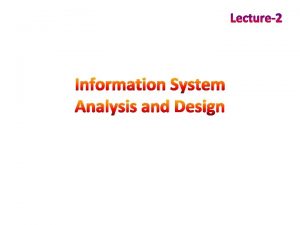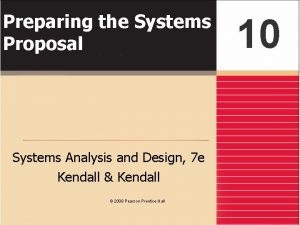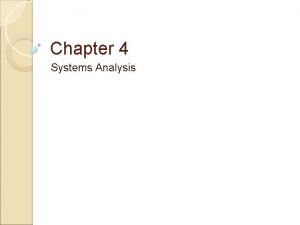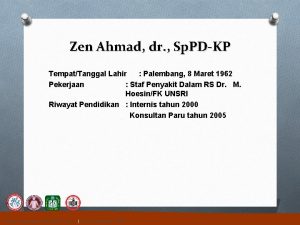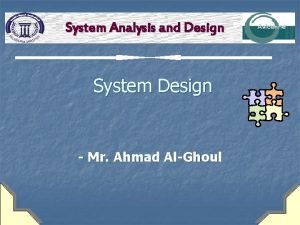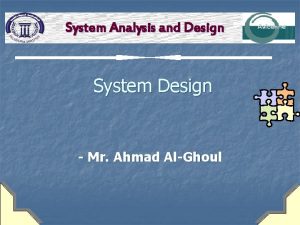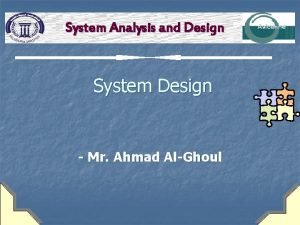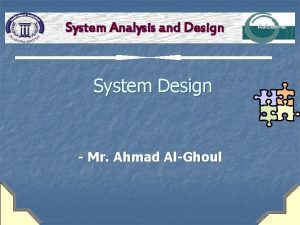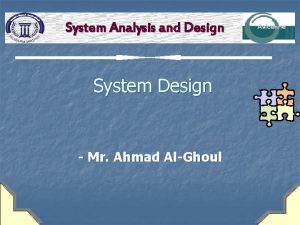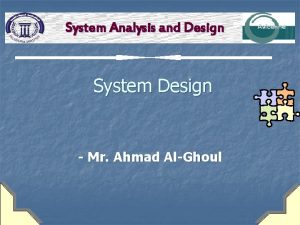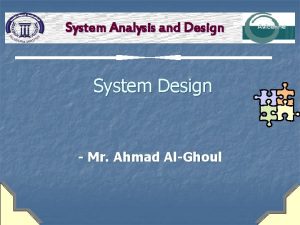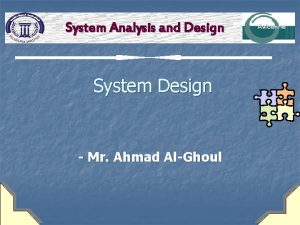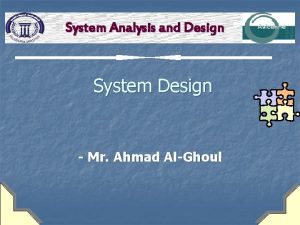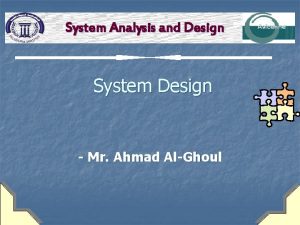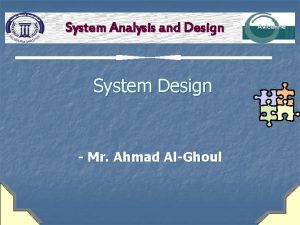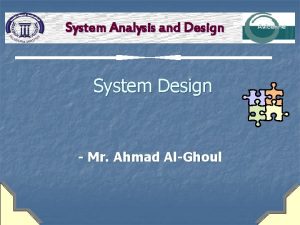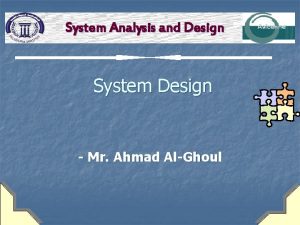System Analysis and Design System Design Mr Ahmad


















![Reference [1] System Analysis and Design, Sixth Edition Authors: Gary B. Shelly, Thomas J. Reference [1] System Analysis and Design, Sixth Edition Authors: Gary B. Shelly, Thomas J.](https://slidetodoc.com/presentation_image_h/0fe99f452b9bd604c6668f8e02c9e2ac/image-19.jpg)
- Slides: 19

System Analysis and Design System Design - Mr. Ahmad Al-Ghoul

learning Objectives § Describe data relationships § Define cardinality, and use cardinality notation § Draw an entityrelationship diagram System Analysis and Design Avicenna System Design 2

Entity-Relationship Diagrams n What Is an ERD? A picture showing the information created, stored, and used by a business system. n ERD is network model that describes stored data of a system at a high level of abstraction. n Entities generally represent similar kinds of information n Lines drawn between entities show relationships among the data n High level business rules are also shown n System Analysis and Design Avicenna System Design 3

Entity-Relationship Diagrams n Representing entities we represent an entity by a named rectangle use a singular noun, or adjective + noun n refer to one instance in naming n n CUSTOMER System Analysis and Design Avicenna System Design PART-TIME EMPLOYEE 4

Entity-Relationship Diagrams n Entity types and instances n n an entity type is a classification of entity instances Example Ahmad Amal Osama SUPPLIER System Analysis and Design Avicenna System Design 5

Entity-Relationship Diagrams n Relationship n is an association between two entities n we may wish to store information about the association Relationships should have active verb names n often recognised by a verb or n "entity + verb + entity" eg CUSTOMER places ORDER n n n relationships capture the "business rules" of the system The first entity in the relationship is the parent entity; the second entity in the relationship is the child entity Relationships go in both directions System Analysis and Design Avicenna System Design 6

Entity-Relationship Diagrams n n A Relationship Type is a relevant business association between two Entity Types. A Relationship is an occurrence of a relationship type. Marketing Finance MIS DEPT employs employs System Analysis and Design Avicenna System Design Yosef Ali Osama Mlkawi Ahmad Al ghoul EMPLOYEE 7

Entity-Relationship Diagrams n Types of Relationships n n Three types of relationships can exist between entities One-to-one relationship (1: 1): One instance in an entity (parent) refers to one and only one instance in the related entity (child) System Analysis and Design Avicenna System Design 8

Entity-Relationship Diagrams n Types of Relationships n One-to-many relationship (1: M): One instance in an entity (parent) refers to one or more instances in the related entity (child) System Analysis and Design Avicenna System Design 9

Entity-Relationship Diagrams n Types of Relationships n Many-to-many relationship (M: N): exists when one instance of the first entity (parent) can relate to many instances of the second entity (child), and one instance of the second entity can relate to many instances of the first entity. System Analysis and Design Avicenna System Design 10

Entity-Relationship Diagrams n Types of Relationships n Many-to-many relationship (M: N): n this relationship can not represent physically so we solve this problem by dividing it to two (1: M) relationships. n The relationship between STUDENT and CLASS is many-tomany, one student can take many classes, and one class can have many students. n To solve the problem of this relationship note that the event or transaction that links the two entities is actually a third entity, called Associative entity that has its own characteristics. n In the next section (normalization) you will see how we will solve this problem. System Analysis and Design Avicenna System Design Associative Entity 11

Entity-Relationship Diagrams n Cardinalities in relationships The cardinality of a relationship is the number of instances of one entity type that may be associated with each instance of the other entity type. n An analyst can model this interaction by adding cardinality notation, which uses special symbols to represent the relationship. n System Analysis and Design Avicenna System Design 12

Entity-Relationship Diagrams n Cardinality notation: Notation that shows relationships between entities. n Crow’s foot notation: A type of cardinality notation. It is called crow's foot notation because of the shapes, which include circles, bars, and symbols, that indicate various possibilities. A single bar indicates one, a double bar indicates one and only one, a circle indicates zero, and a crow's foot indicates many. n System Analysis and Design Avicenna System Design 13

Entity-Relationship Diagrams Crow's foot notation is a common method of indicating cardinality. The four examples show you can use various symbols to describe the relationships between entities. System Analysis and Design Avicenna System Design 14

Entity-Relationship Diagrams In the first example of cardinality notation, one and only one CUSTOMER can place anywhere from zero to many of the ORDER entity. In the second example, one and only one ORDER can include one ITEM ORDERED or many. In the third example, one and only one EMPLOYEE can have one SPOUSE or none. In the fourth example, one EMPLOYEE, or many employees, or none, can be assigned to one PROJECT, or many projects, or none. System Analysis and Design Avicenna System Design 15

Entity-Relationship Diagrams n The entity-relationship diagram may be used to determine record keys n n When the relationship is one-to-many, the primary key of the file at the one end of the relationship should be contained as a foreign key on the file at the many end of the relationship A many-to-many relationship should be divided into two one-to-many relationships with an associative entity in the middle System Analysis and Design Avicenna System Design 16

Sequence Summary n n n An entity-relationship diagram (ERD) is a graphic representation of all system entities and the relationships among them The ERD is based on entities and data stores in DFDs prepared during the systems analysis phase The three basic relationships represented in an ERD are one-to-one (1: 1), one-to-many (1: M), and manyto-many (M: N) In a M: N relationship, the two entities are linked by an associative entity The relationship between two entities also is referred to as cardinality A common form if cardinality notation is called crow’s foot notation, which uses various symbols to describe the characteristics of the relationship System Analysis and Design Avicenna System Design 17

Sequence Summary n In this Sequence we have § Defined entity relationship diagram (ERD) § Defined and distinguished between entity type and entity instance § Defined and distinguished between relationship and relationship type § Explained types of relationships § Defined cardinality, and used cardinality notation System Analysis and Design Avicenna System Design 18
![Reference 1 System Analysis and Design Sixth Edition Authors Gary B Shelly Thomas J Reference [1] System Analysis and Design, Sixth Edition Authors: Gary B. Shelly, Thomas J.](https://slidetodoc.com/presentation_image_h/0fe99f452b9bd604c6668f8e02c9e2ac/image-19.jpg)
Reference [1] System Analysis and Design, Sixth Edition Authors: Gary B. Shelly, Thomas J. Cashman and Harry J. Rosenblatt Publisher: SHELLY CASHMAN SEWIES. System Analysis and Design Avicenna System Design 19
 Explain input and output form design
Explain input and output form design Advantages of structured analysis
Advantages of structured analysis Fact finding methods in system development
Fact finding methods in system development Feasibility matrix example
Feasibility matrix example User interface design in system analysis and design
User interface design in system analysis and design Dialogue design
Dialogue design Nine characteristics of system
Nine characteristics of system System security in system analysis and design
System security in system analysis and design Title proposal for system analysis and design
Title proposal for system analysis and design Objectives of system analysis
Objectives of system analysis Vostrine
Vostrine Risala asbab-i-baghawat-i-hind
Risala asbab-i-baghawat-i-hind Phuc dao
Phuc dao Dr fawad randhawa
Dr fawad randhawa Jawad ahmad md
Jawad ahmad md Nur ahmad husin
Nur ahmad husin Ain syafinaz mohd razip
Ain syafinaz mohd razip Neurosis vs psychosis
Neurosis vs psychosis Seitz filter funnel
Seitz filter funnel Dr nur ahmad tabri
Dr nur ahmad tabri






